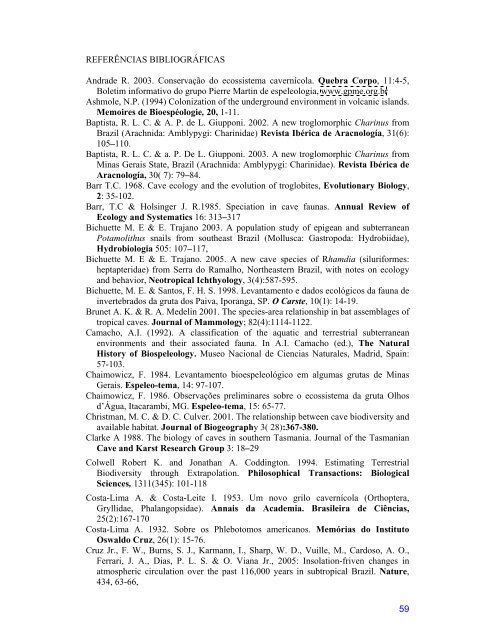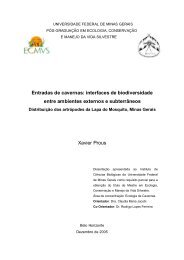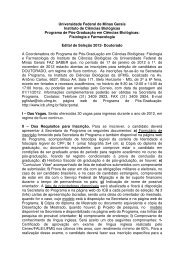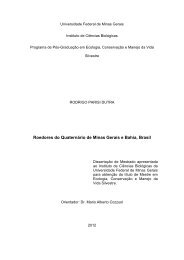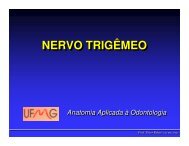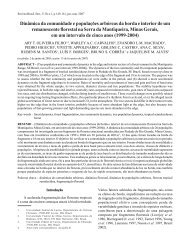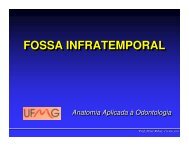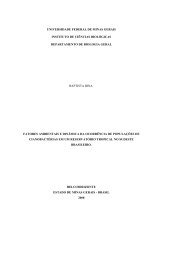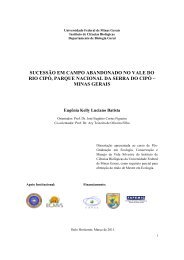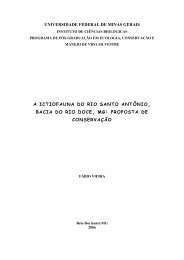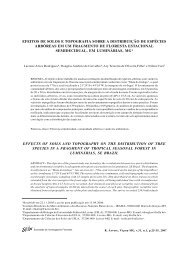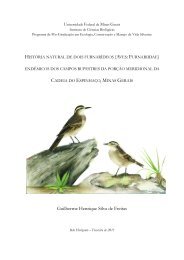ecologi ae conservação das comuni dades de i ... - ICB - UFMG
ecologi ae conservação das comuni dades de i ... - ICB - UFMG
ecologi ae conservação das comuni dades de i ... - ICB - UFMG
You also want an ePaper? Increase the reach of your titles
YUMPU automatically turns print PDFs into web optimized ePapers that Google loves.
REFERÊNCIAS BIBLIOGRÁFICASAndra<strong>de</strong> R. 2003. Conservação do ecossistema cavernícola. Quebra Corpo, 11:4-5,Boletim informativo do grupo Pierre Martin <strong>de</strong> espeleologia, www.gpme.org.brAshmole, N.P. (1994) Colonization of the un<strong>de</strong>rground environment in volcanic islands.Memoires <strong>de</strong> Bioespéologie, 20, 1-11.Baptista, R. L. C. & A. P. <strong>de</strong> L. Giupponi. 2002. A new troglomorphic Charinus fromBrazil (Arachnida: Amblypygi: Charinid<strong>ae</strong>) Revista Ibérica <strong>de</strong> Aracnología, 31(6):105 110.Baptista, R. L. C. & a. P. De L. Giupponi. 2003. A new troglomorphic Charinus fromMinas Gerais State, Brazil (Arachnida: Amblypygi: Charinid<strong>ae</strong>). Revista Ibérica <strong>de</strong>Aracnología, 30( 7): 79 84.Barr T.C. 1968. Cave ecology and the evolution of troglobites, Evolutionary Biology,2: 35-102.Barr, T.C & Holsinger J. R.1985. Speciation in cave faunas. Annual Review ofEcology and Systematics 16: 313 317Bichuette M. E & E. Trajano 2003. A population study of epigean and subterraneanPotamolithus snails from southeast Brazil (Mollusca: Gastropoda: Hydrobiid<strong>ae</strong>),Hydrobiologia 505: 107 117,Bichuette M. E & E. Trajano. 2005. A new cave species of Rhamdia (siluriformes:heptapterid<strong>ae</strong>) from Serra do Ramalho, Northeastern Brazil, with notes on ecologyand behavior, Neotropical Ichthyology, 3(4):587-595.Bichuette, M. E. & Santos, F. H. S. 1998. Levantamento e dados ecológicos da fauna <strong>de</strong>invertebrados da gruta dos Paiva, Iporanga, SP. O Carste, 10(1): 14-19.Brunet A. K. & R. A. Me<strong>de</strong>lin 2001. The species-area relationship in bat assemblages oftropical caves. Journal of Mammology; 82(4):1114-1122.Camacho, A.I. (1992). A classification of the aquatic and terrestrial subterraneanenvironments and their associated fauna. In A.I. Camacho (ed.), The NaturalHistory of Biospeleology. Museo Nacional <strong>de</strong> Ciencias Naturales, Madrid, Spain:57-103.Chaimowicz, F. 1984. Levantamento bioespeleológico em algumas grutas <strong>de</strong> MinasGerais. Espeleo-tema, 14: 97-107.Chaimowicz, F. 1986. Observações preliminares sobre o ecossistema da gruta Olhosd Água, Itacarambi, MG. Espeleo-tema, 15: 65-77.Christman, M. C. & D. C. Culver. 2001. The relationship between cave biodiversity andavailable habitat. Journal of Biogeography 3( 28):367-380.Clarke A 1988. The biology of caves in southern Tasmania. Journal of the TasmanianCave and Karst Research Group 3: 18 29Colwell Robert K. and Jonathan A. Coddington. 1994. Estimating TerrestrialBiodiversity through Extrapolation. Philosophical Transactions: BiologicalSciences, 1311(345): 101-118Costa-Lima A. & Costa-Leite I. 1953. Um novo grilo cavernícola (Orthoptera,Gryllid<strong>ae</strong>, Phalangopsid<strong>ae</strong>). Annais da Aca<strong>de</strong>mia. Brasileira <strong>de</strong> Ciências,25(2):167-170Costa-Lima A. 1932. Sobre os Phlebotomos americanos. Memórias do InstitutoOswaldo Cruz, 26(1): 15-76.Cruz Jr., F. W., Burns, S. J., Karmann, I., Sharp, W. D., Vuille, M., Cardoso, A. O.,Ferrari, J. A., Dias, P. L. S. & O. Viana Jr., 2005: Insolation-friven changes inatmospheric circulation over the past 116,000 years in subtropical Brazil. Nature,434, 63-66,59


